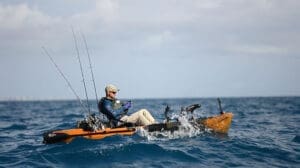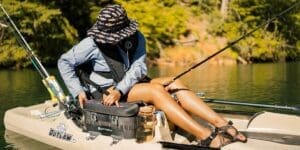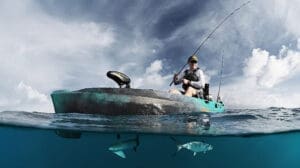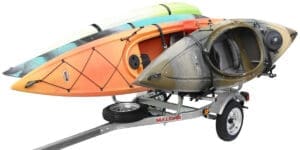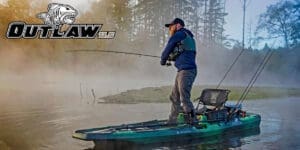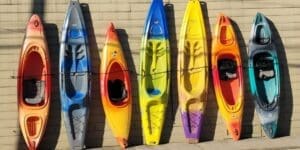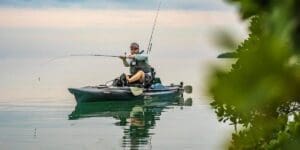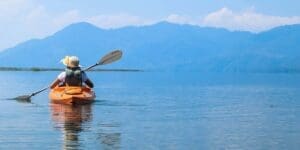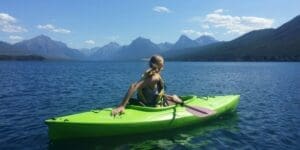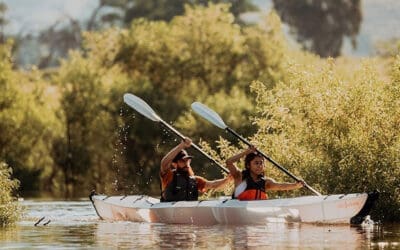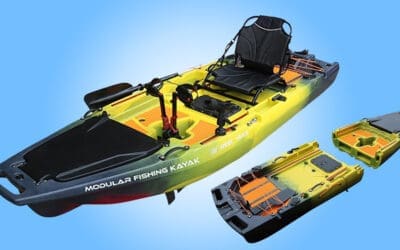When choosing the perfect kayak, consider where you’ll paddle and prioritize safety with the right gear like life jackets and first aid kits. Evaluate kayak materials for durability and performance, and learn about different kayak types to match your preferences. Decide between sit-on-top for easy access or sit-in for better control, and keep budget, storage, and skill level in mind. Don’t forget to explore specialty options like folding or inflatable kayaks. Understanding these basics will lead you to a well-informed decision.
Some Key Points
- Consider the intended use and water conditions for the kayak.
- Evaluate the budget and storage options for the kayak.
- Match the kayak category to your skill level for optimal performance.
- Choose between sit-on-top and sit-in kayaks based on preferences.
- Explore specialty options like folding, inflatable, tandem, or pedal-powered kayaks.
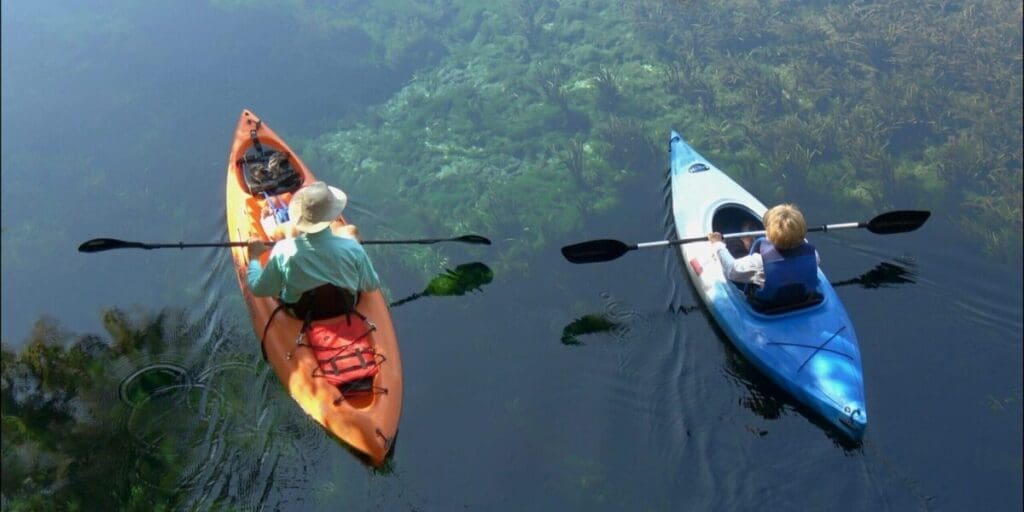
Kayak Usage Environments
When selecting the perfect kayak, consider the environment in which you will be paddling to guarantee the most suitable boat for your needs. Safety precautions and proper equipment are crucial for your adventures. Always wear a life jacket, carry a whistle, and pack a first aid kit to make sure a safe and enjoyable experience. Additionally, be mindful of the environmental impact and practice conservation while on the water. Respect wildlife, follow designated waterways, and avoid disturbing sensitive habitats. By choosing the right kayak for the specific environment you plan to explore, you not only enhance your safety but also contribute to the preservation of natural ecosystems. Enjoy the freedom of paddling while being a responsible steward of the environment.
Kayak Types and Features
Consider the various types of kayaks available, each with unique features to suit different preferences and activities. When selecting your kayak, keep in mind the materials used in its construction and its importance for long-term use. Understanding paddling techniques and safety measures is essential for a secure and enjoyable experience on the water. Here are four key points to take into account: Additionally, think about the specific environment where you’ll be using your kayak, whether it’s calm lakes, rushing rivers, or open seas, as this will influence your choice. Investing time in mastering kayak paddle strokes can significantly enhance your maneuverability and efficiency on the water, making your outings more rewarding. Lastly, don’t forget to choose the right safety gear to ensure peace of mind during your adventures.
- Kayak Materials: Evaluate the kayak’s construction materials for durability and performance in different water conditions.
- Durability: Choose a kayak that can withstand the wear and tear of your intended activities.
- Paddling Techniques: Familiarize yourself with proper paddling techniques to enhance your efficiency and safety on the water.
- Safety Features: Look for kayaks equipped with safety features like grab handles, flotation devices, and reflective gear for added security.
Sit-on-top Kayak vs Sit-in Kayaks
Evaluate the differences between sit-on-top and sit-in kayaks to make an informed decision based on your preferences and intended usage. Sit-on-top kayaks offer easy access, are self-draining, and provide a more relaxed paddling experience. They are ideal for warmer weather and beginners. On the other hand, sit-in kayaks offer better control, protection from the elements, and are more efficient in rough waters. They have covered cargo compartments for storage and are suitable for colder weather. In comparison with canoes, sit-on-top kayaks are more stable and easier to re-enter if capsized, while sit-in kayaks provide better speed and protection. Consider the pros and cons of each type to determine which aligns best with your kayaking needs.

Kayak Category Selection Tips
To choose the right kayak category, assess your intended use and skill level for peak performance on the water. When selecting your kayak type, consider budget considerations and storage solutions to make the most of your kayaking experience:
- Budget considerations: Determine how much you are willing to invest in your kayak, keeping in mind additional costs for accessories and maintenance.
- Storage solutions: Think about where you will store your kayak when not in use, considering space limitations and whether you will need to transport or protect it.
- Intended use: Decide if you will be kayaking on calm lakes, flowing rivers, or open seas to match the kayak category to your preferred water conditions.
- Skill level: Choose a kayak that suits your expertise level, whether you are a beginner looking for stability or an experienced paddler seeking speed and agility.

Specialty Kayak Options
When looking for specialty kayak options, explore folding, inflatable, tandem, and pedal-powered models to cater to specific needs and preferences. Inflatable kayaks save storage space, are versatile, and offer varying levels of speed and ruggedness compared to folding kayaks, which are portable, suitable for travel, and provide handling similar to touring boats. Tandem kayaks save costs, offer stability, and are perfect for paddling with a partner or kids. Pedal-powered kayaks provide hands-free operation, stability, and increased endurance. Consider the table below for a quick comparison:
| Specialty Kayak | Inflatable | Folding |
|---|---|---|
| Solo Option | Versatile | Portable |
| Tandem Option | Stable | Comparable to touring boats |
| Features | Varying speed | Suitable for travel |
Choose the option that best suits your needs and enjoy the freedom it brings to your kayaking experience.
Additional Considerations for Kayak Choosing
Take into account various factors such as weight capacity, materials, and accessories to make certain the kayak you choose aligns with your desired performance and activities.
- Kayak Material Comparisons: Compare lightweight options like polyethylene, ABS plastic, and composites for durability and performance.
- Weight Capacity Considerations: Make sure the kayak can safely support your weight and any gear you plan to bring along.
- Length, Depth, and Width: Evaluate how these dimensions affect the kayak’s stability, speed, and maneuverability.
- Accessory Enhancements: Consider options like skegs, tracking fins, and rudders to improve performance in different water conditions.
Make an informed decision based on these essential aspects to enjoy the ultimate freedom on the water.
Expert Insights and Kayak Suggestions
Considering the various factors involved in selecting the perfect kayak, expert insights and shopping suggestions play a valuable role in guiding your decision-making process. Expert recommendations from seasoned kayakers like A.J. Price and Lance Astles can provide you with valuable insights into the best kayak options for your needs. Additionally, exploring online resources and community forums can help you gather more information on gear essentials like spray skirts and kayak storage. To assist you further, here is a table highlighting some popular kayak choices:
| Kayak Model | Type | Features |
|---|---|---|
| Perception Joyride 10.0 | Sit-in | Recreational, comfortable, easy to maneuver |
| Pelican Sentinel 100XP | Sit-on-top | Angler kayak, stable, suitable for fishing |
| Hobie Mirage Passport 12.0 | Sit-on-top | Pedal-powered, hands-free operation, stable |
Explore these options and make an informed decision based on your preferences and needs.
Kayaking Time!
Now that you have a better understanding of the various kayak options available, you can confidently choose the perfect one for your adventures on the water. Consider your preferred environment, kayak type, and special features to guarantee a safe and enjoyable experience. Remember to factor in expert insights and shopping suggestions to make the best decision for your needs. Happy paddling!
Questions & Answers

How Do You Properly Transport a Kayak on the Roof of Your Car?
When transporting your kayak on the roof of your car, make sure to use roof racks for secure kayak storage. Position the kayak on the racks, securing it tightly with straps. Double-check all connections before hitting the road to confirm a safe journey. Remember, proper setup is key for worry-free travels. Enjoy the freedom of exploring new waters with your trusty kayak securely fastened atop your vehicle.
Are There Any Specific Safety Tips for Kayaking in Different Types of Water Conditions?
When kayaking in different water conditions, always prioritize safety. Learn paddling techniques to navigate effectively. Have proper safety gear like life jackets and helmets. Be familiar with rescue procedures in case of emergencies. Stay updated on weather conditions to avoid risks. By being prepared and taking precautions, you can enjoy your kayaking experience with freedom and peace of mind.
What Are Some Common Maintenance Tips for Keeping a Kayak in Good Condition?
To maintain your kayak in top shape, store it properly to prevent damage. Clean your kayak regularly by rinsing off saltwater and dirt. Fix any scratches with a kayak repair kit. Think about upgrading equipment like paddles or seats for better performance. These maintenance practices will guarantee your kayak stays in good condition and ready for your next adventure on the water.
Are There Any Specific Regulations or Permits Required for Kayaking in Certain Bodies of Water?
When kayaking, remember to check for any permit requirements or waterway regulations to make sure you’re in compliance. These rules might vary depending on the body of water you’re paddling in. By following these guidelines, you can enjoy your kayaking experience without restrictions. Remember to always prioritize your safety and respect the environment while out on the water. Happy paddling!
Can You Recommend Any Beginner-Friendly Kayaking Routes or Destinations for Someone New to the Sport?
For beginner-friendly kayaking routes, start with calm lakes or slow-moving rivers. Opt for stable recreational kayaks and essential gear like life jackets. Top destinations include peaceful lakeside spots or gentle river stretches. Research local rental options for the best gear and guidance. Enjoy the freedom of exploring nature at your own pace. Remember to prioritize safety and have fun on your kayaking adventures!

























